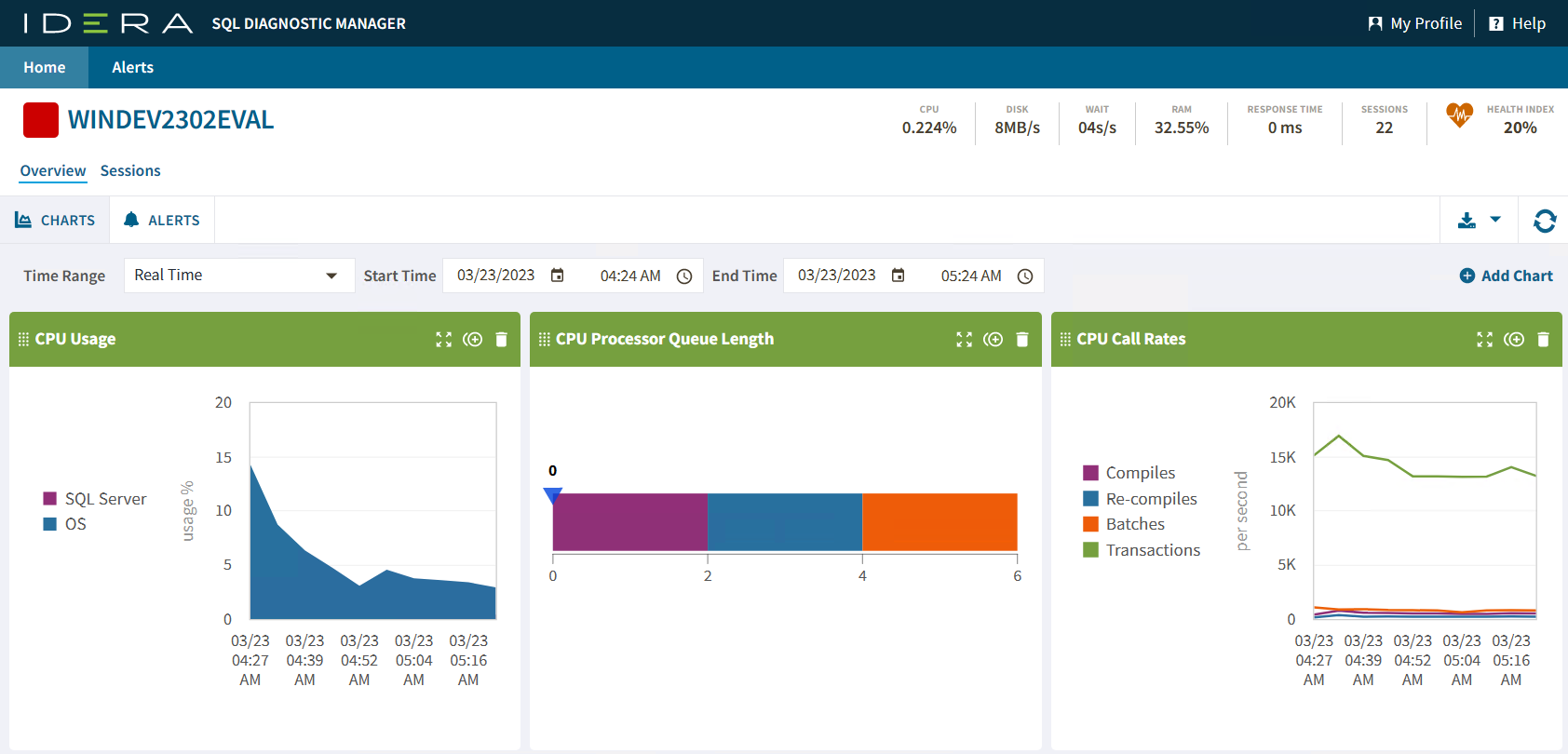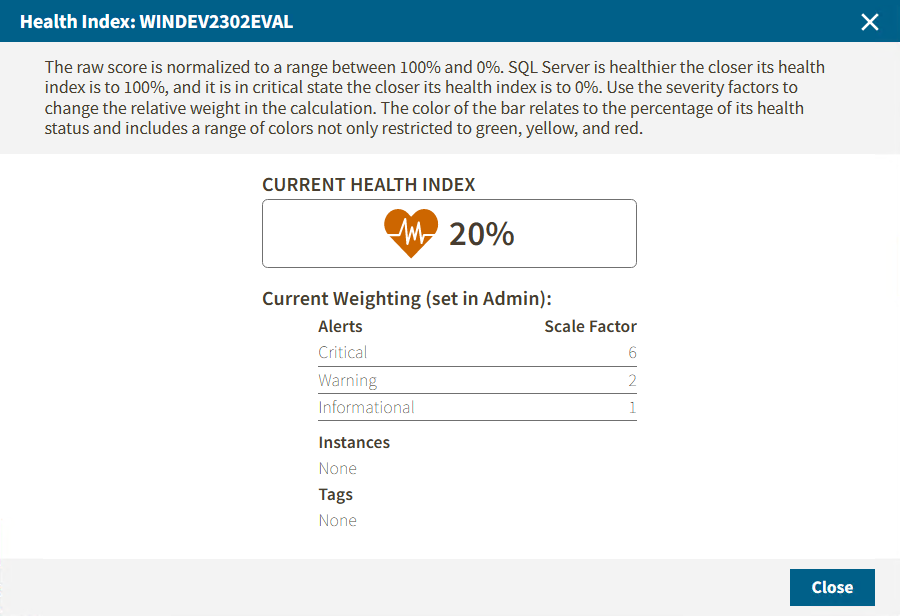Page History
One of the features included in the SQLDM Web Console is the single instance view. You can access this view by double-clicking on the thumbnail of your selected SQL Server instance. By doing this, you will be able to check your SQL Server instance status.
For better control, the single instance view presents the Overview and Sessions options that help you to easily monitor your instance.
Besides, the single instance view provides you with instance management tools and options, such as:
Anchor AHS AHS
Dashboard Header
| AHS | |
| AHS |
The Dashboard Header summarizes the SQL Server instance performance.
In this section, you can find the server summary that shows the metrics of the selected instance, such as:
Server Name
Displays the server name of your instance.
CPU
Refers to the average percentage of SQL Server processor usage on the computer hosting the SQL Server instance.
Disk
Refers to the number of physical reads and writes made by the SQL Server instance between refreshes.
Wait
Displays the Total Server Waits for the monitored SQL Server instance.
RAM
Displays the percentage of allocated memory to SQL Server instance in usage.
Response Time
Displays the calculated time that SQL Diagnostic Manager needs to send a simple SQL command to the instance, have it processed, and receive the returned result set.
Sessions
Displays the current number of sessions in an SQL Server instance.
Health Index
Shows the current instance health in percentage. To have a wider view of this option click on the metric and the following window will pop up.
Anchor HR HR
Time Range Filter
| HR | |
| HR |
The Time Range Filter provides SQL Server instance information pertaining to its state at the time a standard snapshot is taken. You can use this information to diagnose and resolve issues to keep the issue from happening again. You can modify it by changing the start and end time and date.
The single instance dashboard includes an overview section for the selected monitored SQL server and specific category views. SQL Diagnostic Manager users are able to obtain details on sessions, queries, resources, and databases. Click image to view full size.
| Info | ||
|---|---|---|
| ||
When the monitored instance it is registered in SQL Workload Analysis, the Launch SWA icon displays on the right side of the History Range Control. Click the Launch SWA icon to be redirected to SQL Workload Analysis. |
In the single instance dashboard, you can find the following sections:
- History Range Control
- Alert and Health Summary
- Prescriptive Analysis Summary
- Server properties
- Prescriptive Analysis
- Alert Timeline
- Alert Categories
- Charts
...
SQL Diagnostic Manager also includes a new History Range Control, located at the top of the Web Console and in the option History Browser in the Desktop Console, both can be modified and be designated a specific start time and date as well as a current snapshot.
...
In this section, you find the health index, the alert status, and the user sessions from SQL Diagnostic Manager. Also, includes shortcuts to filter data through Sessions, Queries, Resources, and Databases.
...
The prescriptive summary shows the previous analysis information and the resulting recommendations summary. You can click any category under Recommendation Summary to be redirected to the Analyze tab in the desktop console
...
In this section view the most important characteristics of your monitored SQL Server instance.
Instance Name
Displays the name of the monitored SQL Server instance or its friendly name assigned in the desktop console.
| Tip |
|---|
Assign a friendly name to your instance that is meaningful to you and easy to identify. |
SQL Version
Indicates the current SQL Server version including service pack and build information on this SQL Server instance.
SQL Edition
Indicates the current SQL Server edition, including Enterprise, Business Intelligence, or Standard, installed on this SQL Server instance.
Running since
Indicates the timestamp associated with the most recent restart of this SQL Server instance.
Clustered
Indicates whether this SQL Server instance is part of a cluster. If it is part of a cluster, SQL Diagnostic Manager displays the name of the active node.
Processors
Indicates the total number of processors associated with this SQL Server instance and how many of these processors are currently in use.
Host
Indicates the name of the server hosting this SQL Server instance.
Host Memory (GB)
Indicates the total amount of memory on the server hosting this SQL Server instance.
Host OS
Indicates the current operating system on the server hosting this SQL Server instance.
Data Size
Displays the data size of the server.
Log Size
Displays the log size of the server.
...
The Prescriptive Analysis panel shows a summary of the performed Analyses, this panel shows the Date, the Duration, the Task Type, the number of recommendations, the Priority, and you can click the Show Recommendations to review the list of recommendations of each Analysis.
...
This graph shows a summary of the alert categories, CPU, Memory, I/O, Databases, Logs, Queries, Services, Sessions, Virtualization, Operational and Custom. This graph is color-coded depending on the status of the alerts inside each category.
...
This alert timeline view allows you to easily identify the highest alert for your monitored SQL Server instance and the highest alert for a specific category.
Configure the Alert Category graph, following these steps:
- Click Edit, located next to the Alert Timeline graph.
- Check or uncheck the checkboxes located under the Visible column.
- Or, reorganize the Order column with the listed numbers preferred.
- Click Save.
...
The single instance dashboard includes the option MANAGE GRAPHS. This option allows you to choose the following graphs to be displayed in the overview single instance view:
Cache
The Cache chart tracks the database and procedure processes using a buffer pool of memory on your monitored SQL Server instance.
CPU
The CPU chart tracks the performance of the processor used by your monitored SQL Server.
Custom Counters
The Custom Counters chart displays the statistics for a selected custom counter on a monitored SQL Server instance.
Databases
The Databases chart tracks the performance of the databases on your monitored SQL Server.
Disk
The Disk chart tracks the performance of the disk used by your monitored SQL Server.
File Activity
The File Activity chart displays the top five database files with the highest relative activity since the last refresh.
Lock Waits
The Lock Waits chart tracks the total number waits caused when a task is waiting to acquire a lock on your monitored SQL Server.
Memory
The Memory chart tracks the usage and availability of memory on your monitored SQL Server computer.
Network
The Network chart tracks the performance of the network connection being used by your monitored SQL Server.
Server Waits
The Server Waits chart tracks the total number and time spent on waits affecting your monitored SQL Server.
Sessions
The Sessions chart tracks the performance of the active and blocked sessions running on your monitored SQL Server.
tempDB
The Tempdb chart tracks the status of the tempdb database on your monitored SQL Server instance.
Virtualization
The Virtualization chart tracks the performance of your virtual machine or host, depending on the selection in the panel.
...
The single instance dashboard contains the Overview, Sessions, Queries, Query Waits, Resources, Databases, and Alerts tabs where you can see metrics and information on these category views.
From these tabs you can:
...
Access the single instance dashboard
...



